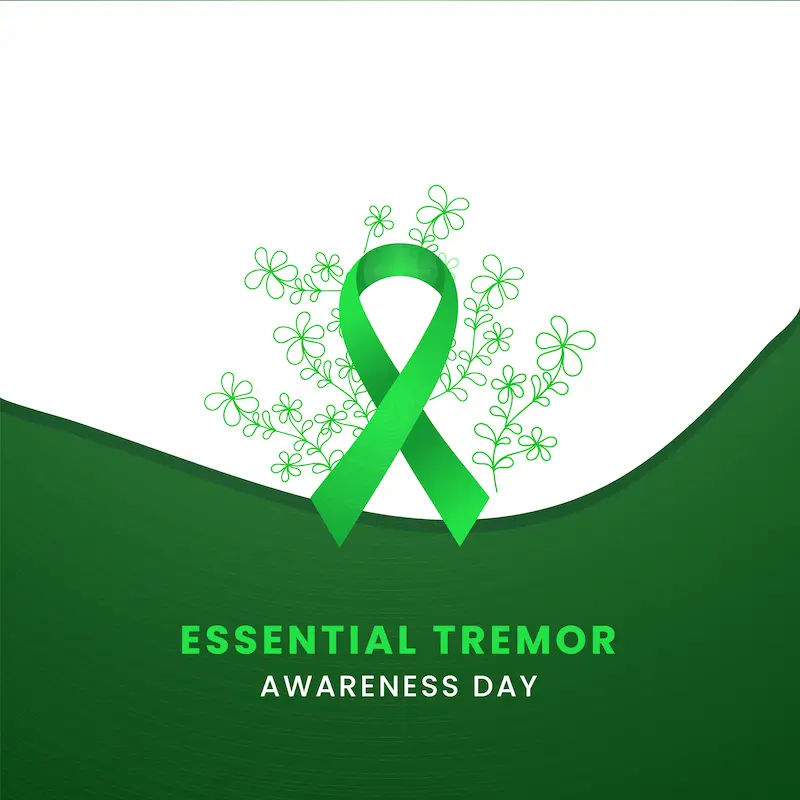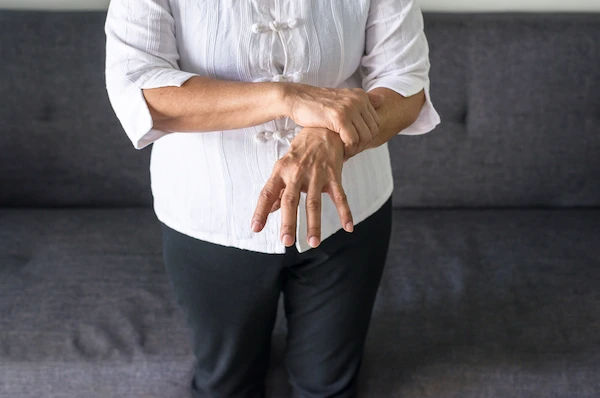Tremors Explained; Your Guide to the Common Types and What They Mean
Learn about the different types of tremors, their causes, symptoms, and treatment options. Understand when tremors are harmless and when to seek medical advice.

.webp?tr=q-80,f-webp,w-350,dpr-2,c-at_max 700w)
Introduction
Have you ever reached for a cup of coffee and noticed your hand shaking slightly? Or perhaps you’ve seen a loved one struggle with a persistent, uncontrollable quiver. Tremors—the involuntary, rhythmic shaking movements of one or more parts of the body—are more common than you might think. While often associated with anxiety or Parkinson's disease, the world of tremors is vast and varied. Understanding the different types is the first step toward addressing them. This guide will demystify the common types of tremors, explaining their distinct characteristics, causes, and what they might signify for your health. We'll break down complex medical terms into easy-to-understand language, helping you distinguish between a benign essential tremor and a tremor that may require a neurologist's attention. Whether you're seeking answers for yourself or someone else, knowledge is power when navigating this often-misunderstood symptom. Let's dive into the explained details of these common neurological types of movements.
What is a Tremor? The Uncontrollable Shake
At its core, a tremor is an involuntary, rhythmic muscle contraction that results in shaking movements in one or more parts of the body. It’s the most common of all involuntary movements and can affect the hands, arms, head, face, voice, torso, and legs. Tremors are not a disease in themselves but rather a symptom of an underlying condition. This condition could be as simple as fatigue or as complex as a neurological disorder.
The Brain-Body Connection: Why Tremors Happen
Tremors occur due to glitches in the complex feedback loops within the brain that control muscles. Think of it like a thermostat that’s malfunctioning. Specific areas of the brain, such as the cerebellum (which coordinates movement) and the basal ganglia (which helps initiate smooth, purposeful movement), send signals to the muscles. When there’s a disruption in this communication network—often related to neurotransmitters like dopamine—the result can be oscillating, shaky movements instead of smooth, controlled ones.
The Two Main Categories: Resting vs. Action Tremors
The most critical distinction doctors make is between resting and action tremors. This classification is a primary clue in diagnosing the underlying cause.
Resting Tremors: The Shake at Ease
A resting tremor occurs when a muscle is completely relaxed and supported against gravity. For example, your hands might shake while resting in your lap or when your arms are dangling at your sides. The tremor often diminishes or disappears when you voluntarily move the limb. This type of tremor is classically associated with Parkinson's disease and is a key diagnostic feature.
Action Tremors: The Shake in Motion
Action tremors are produced by any voluntary muscle contraction. They are further subdivided into several types:
Postural Tremor (Holding Against Gravity)
This occurs when you hold a position against gravity, like extending your arms straight out in front of you. Essential tremor is the most common example of a postural tremor.
Kinetic Tremor (Intentional Movement)
This tremor appears during any voluntary movement, such as touching your finger to your nose. A specific type, intention tremor, worsens as you get closer to a target and is often linked to cerebellar damage, like from multiple sclerosis or a stroke.
Consult a Neurologist for the best advice
Isometric Tremor (Muscle Contraction)
This occurs when you contract a muscle without moving it, such as making a tight fist or holding a heavy book steady.
A Closer Look at the Most Common Tremor Types
Now that we understand the categories, let's explore the specific conditions associated with them.
Essential Tremor: The Most Prevalent Type
Essential tremor (ET) is the most common movement disorder, affecting far more people than Parkinson's disease. It's typically a postural tremor but can also have a kinetic component. Key characteristics include:
- Pattern: A "yes-yes" or "no-no" shaking of the hands and head.
- Triggers: Often worsened by stress, fatigue, caffeine, and temperature extremes.
- Unique Insight: A key differentiator is that ET often improves temporarily with a small amount of alcohol—a factor doctors may ask about but do not recommend as a treatment. ET is frequently hereditary, with about half of all cases having a family history.
Parkinsonian Tremor: The "Pill-Rolling" Shake
The Parkinsonian tremor is the classic resting tremor. It's often one of the first signs of Parkinson's disease. Its hallmarks are:
- Pattern: A "pill-rolling" motion of the thumb and forefinger while the hand is at rest.
- Associated Symptoms: It's usually accompanied by bradykinesia (slowness of movement), rigidity, and postural instability.
- Progression: It typically starts asymmetrically, affecting one side of the body more than the other.
Dystonic Tremor: Caused by Incorrect Muscle Signals
This tremor occurs in people with dystonia, a movement disorder where incorrect brain signals cause muscles to contract excessively. The tremor is often:
- Irregular: The shaking can be more jerky and irregular compared to the rhythmic nature of ET or Parkinsonian tremors.
- Position-Specific: It might occur only in certain body positions and can often be relieved by touching the affected body part.|
Cerebellar Tremor: A Sign of Brain Damage
As the name implies, this tremor is caused by damage to the cerebellum from conditions like a stroke, tumour, multiple sclerosis, or chronic alcoholism. It is primarily a severe intention tremor, making targeted actions like pressing a button or drinking from a glass extremely difficult.
Physiologic Tremor: The Shake We All Have
This is a normal, very low-amplitude tremor that is present in every healthy person. It's so fine that it's usually invisible to the naked eye. It's caused by the natural physical properties of our limbs and the constant tiny feedback adjustments our bodies make to maintain posture.
Enhanced Physiologic Tremor: When Normal Becomes Noticeable
This is not a separate disease but a noticeable worsening of the normal physiologic tremor.
Common triggers include:
- Metabolic: Hyperthyroidism, low blood sugar.
- Medications: Asthma medications, certain antidepressants, stimulants.
- Lifestyle: Stress, anxiety, fatigue, caffeine, alcohol withdrawal.
The good news is that this tremor is usually reversible once the underlying trigger is identified and addressed.
Diagnosis: How Doctors Identify the Type of Tremor
Diagnosing a tremor involves a thorough evaluation. A neurologist will start with a detailed history and a physical/neurological exam. They may ask you to perform tasks like writing, drawing a spiral, or holding your arms outstretched. In some cases, tests like blood work (to rule out thyroid issues), MRI scans (to check for brain lesions), or electromyography (EMG) may be needed to measure muscle activity and pinpoint the tremor type accurately. If your symptoms are persistent or worsening, consulting a neurologist via Apollo24|7 can provide an initial expert evaluation and guidance on next steps.
Living with Tremors: Management and Treatment Options
Treatment depends entirely on the underlying cause. For Enhanced Physiologic Tremor, lifestyle changes like reducing caffeine and managing stress may be sufficient. For more impactful tremors like ET or Parkinson's, options include:
- Medications: Beta-blockers (like propranolol) and anti-seizure drugs are first-line treatments for ET. Parkinson's disease is treated with medications that increase dopamine levels.
- Therapy: Physical and occupational therapy can help improve muscle control, coordination, and recommend adaptive devices.
- Advanced Treatments: For severe, medication-resistant tremors, options like Deep Brain Stimulation (DBS) or focused ultrasound thalamotomy can be highly effective.
When to See a Doctor: Don't Ignore These Signs
While not all tremors are a sign of a serious condition, you should consult a doctor if:
- The tremor suddenly appears.
- It interferes with daily activities like writing, eating, or working.
- It is accompanied by other symptoms like stiffness, slow movement, or changes in gait.
- The shaking worsens over time.
If your condition does not improve after trying basic lifestyle modifications, book a physical visit to a neurologist with Apollo24|7 for a comprehensive diagnosis and personalised treatment plan.
Conclusion
Understanding the common types of tremors is the first step toward managing them effectively. From the widespread Essential Tremor to the distinct Parkinsonian resting tremor, each type has its own characteristics, causes, and treatment pathways. Remember, a tremor is a symptom, not a definitive diagnosis. While it can be alarming to experience unexplained shaking, many causes are manageable or even reversible. The key is not to self-diagnose but to seek professional medical advice. By paying attention to when and how the tremor occurs, you can provide valuable information that will help your doctor make an accurate diagnosis. Armed with this knowledge, you can take a proactive step toward better health and improved quality of life. Don't let uncertainty hold you back—understanding is the foundation of effective action.
Consult a Neurologist for the best advice
Consult a Neurologist for the best advice

Dr. Aditendraditya Singh Bhati
Neurosurgeon
18 Years • MBBS(2004), DNB Neurosurgery(2014); MNAMS; Fellow Neuroendoscopy
Delhi
Apollo Hospitals Indraprastha, Delhi
(100+ Patients)

Dr. Ganeshgouda Majigoudra
Neurologist
10 Years • MBBS, MD ( GENERAL MEDICINE) DM (NEUROLOGY)
Bengaluru
Apollo Clinic, JP nagar, Bengaluru

Dr Rajashekar Mummadi
Neurologist
3 Years • MBBS, DNB General Medicine, DRNB Neurology
Hyderabad
Dr Ram's Neuro Clinic, Hyderabad

Dr. E Prabhakar Sastry
General Physician/ Internal Medicine Specialist
40 Years • MD(Internal Medicine)
Manikonda Jagir
Apollo Clinic, Manikonda, Manikonda Jagir
(150+ Patients)

Dr S Selvin
Neurologist
10 Years • MBBS, MD, DM (Neurology), FINR fellowhsip in Interventional Neuro Radiology
Chennai
Apollo Speciality Hospitals Vanagaram, Chennai
Consult a Neurologist for the best advice

Dr. Aditendraditya Singh Bhati
Neurosurgeon
18 Years • MBBS(2004), DNB Neurosurgery(2014); MNAMS; Fellow Neuroendoscopy
Delhi
Apollo Hospitals Indraprastha, Delhi
(100+ Patients)

Dr. Ganeshgouda Majigoudra
Neurologist
10 Years • MBBS, MD ( GENERAL MEDICINE) DM (NEUROLOGY)
Bengaluru
Apollo Clinic, JP nagar, Bengaluru

Dr Rajashekar Mummadi
Neurologist
3 Years • MBBS, DNB General Medicine, DRNB Neurology
Hyderabad
Dr Ram's Neuro Clinic, Hyderabad

Dr. E Prabhakar Sastry
General Physician/ Internal Medicine Specialist
40 Years • MD(Internal Medicine)
Manikonda Jagir
Apollo Clinic, Manikonda, Manikonda Jagir
(150+ Patients)

Dr S Selvin
Neurologist
10 Years • MBBS, MD, DM (Neurology), FINR fellowhsip in Interventional Neuro Radiology
Chennai
Apollo Speciality Hospitals Vanagaram, Chennai
More articles from Tremor
Frequently Asked Questions
What is the difference between essential tremor and Parkinson's disease?
The key difference is the tremor type. Essential Tremor is primarily an action tremor (worse with movement), while Parkinson's tremor is a resting tremor (present when the muscle is relaxed). ET also rarely involves other motor symptoms like the stiffness and slowness common in Parkinson's.
Can anxiety cause tremors that last for days?
Anxiety can definitely cause or worsen tremors (Enhanced Physiologic Tremor). While the shaking might feel persistent, it typically subsides as the anxiety diminishes. If a tremor triggered by anxiety lasts for days after the stressor is gone, it's advisable to consult a doctor online with Apollo24|7 to rule out other underlying causes.
Are there any natural remedies for shaky hands?
Lifestyle changes can help manage certain tremors. These include reducing caffeine intake, practising stress-reduction techniques like yoga or meditation, ensuring adequate sleep, and avoiding other known triggers. For Essential Tremor, some find mild relief with specific supplements, but you should always discuss these with your doctor first.
Is essential tremor a progressive disease?
Yes, Essential Tremor is generally progressive, meaning it can slowly worsen over time. However, the rate of progression varies greatly from person to person, and many people experience only mild symptoms that don't significantly impact their daily lives for many years.
Can tremors be a sign of a vitamin deficiency?
Yes, deficiencies in vitamins like B12, magnesium, or vitamin D can sometimes lead to neurological symptoms, including tremors. If a deficiency is suspected, a doctor may recommend blood tests. Apollo24|7 offers convenient home collection for tests like vitamin panels to help diagnose such issues.


.webp)